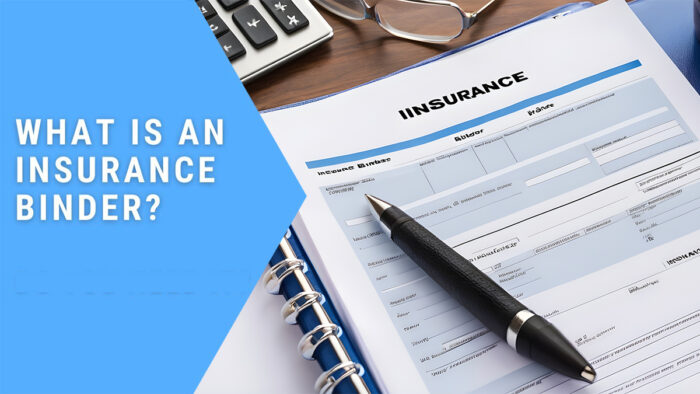An insurance binder is a temporary and provisional insurance contract that acts as proof of insurance coverage before the issuance officially becomes a permanent policy or quote. It is usually provided by an insurance company or insurer that validates that an insurance policy is still active and gives the limits, important terms, insured or policyholder, and coverages.

Apart from this, an insurance binder is very beneficial when proof of insurance is demanded immediately or instantly. For instance, when you want to get or purchase a new vehicle or at a home closing.
Nonetheless, this document is only going to be active and used for a short period, usually 30 to 90 days, giving the insurance agent some time to provide formal insurance policy documents and complete the underwriting process.
On the other hand, it is crucial for the insured to make sure that the permanent insurance quote is provided before the insurance binder expires to access steady coverage. This document is commonly used in homeowners, property and casualty insurance, and auto insurance, but it is still applied to other insurance types.
Types of Insurance Binders
As mentioned previously, insurance binders can be issued for different insurance types, and they include the following:
- Auto insurance binder: Can be used for new vehicles or altering coverage.
- Commercial property insurance binder: It can be used for businesses that need proof of insurance for property and assets.
- Homeowners insurance binder: Crucial for changes in homeownership status or home purchases.
Hence, you have access to various types of coverage using these types of insurance binders, but it all depends on your state’s minimum requirements and what you wish to insure.
How Does It Work?
The working process of an insurance binder is straightforward. Imagine you apply for an insurance quote, but somehow there is a delay in the issuance or allocation of the final quote document.
During this phase, you can use an it as proof of insurance, giving you temporary coverage. Its aim is to assure all parties, including regulatory bodies and lenders, that the insurance policy is active.
What Does It Look Like?
For a person who is looking to consider an insurance binder, it is important that you understand what it looks like and the content or information required or needed. Besides, it is not lengthy and complicated.
- Policy deductibles.
- Insurance limits.
- The effective start and end date of coverage.
- The expiration date.
- Endorsements of the policy (if there are any).
- Coverage type.
- Address of the policyholder.
- Additional insureds (if there are any).
- Policyholder’s name.
- Insurance company or insurance agent’s details.
An insurance binder has the same type of insurance information that you will find on a real insurance certificate.
Who Needs One?
You may be wondering, When do I need an insurance binder? ” How do I know if it is the best option for me? Here are scenarios where this provisional insurance contract is a good alternative. Individuals or businesses that are:
- Closing on a home purchase.
- Financing or leasing a vehicle.
- Entering contracts requiring proof of insurance.
- Changing their insurance coverage or insurance providers.
How to Get an Insurance Binder
To get it, follow these simple steps to begin. You need to:
- Apply for an insurance policy.
- Go through the necessary documents once you complete your insurance application.
- Provide any necessary information or documents to the insurer for underwriting.
- Request an insurance binder if you need immediate proof of insurance coverage.
- The binder will be sent to the mortgage lender electronically.
But you will need to have a copy of the policy declaration page or other finishing document after the policy is issued, since it is a temporary document.
What Should I Do After My Insurance Binder Expires?
If you are awaiting issuance from the insurance provider and your insurance binder is about to expire, before it does, the insurance company should have already issued the permanent policy documents to you. Nevertheless, you should still:
- Check the final policy to make sure it meets your expectations and the coverage in the binder.
- Contact your insurance agent or company if you have not gotten your policy documents before the binder is no longer active.
Frequently Asked Questions
How long does an insurance binder last?
It usually stays active for 30 to 90 days, giving the insurance agent or company time to complete underwriting and issue the final policy.
Is an insurance binder the same as a declaration page?
No, an insurance binder is not the same as a declaration page. It is a temporary document, while a declaration page, on the other hand, is part of the permanent policy document and summarizes the policyholder’s information, limits, and coverage.
Do I need an insurance binder for all types of insurance?
Not necessarily. Insurance binders are most commonly used for property and casualty insurance, such as homeowners insurance, auto insurance, or commercial property insurance. However, they may also be used for other types of insurance coverage in certain situations.
What happens if I don’t receive my permanent policy before the binder expires?
If you don’t receive your permanent policy before the binder expires, you may need to contact your insurance company or agent to request an extension or to expedite the issuance of the permanent policy. It’s important to ensure continuous coverage to avoid any gaps in insurance protection.
Can an insurance binder be extended?
In some cases, insurance binders can be extended if needed. However, this typically requires approval from the insurance company and may involve additional documentation or premium payments.
Do I need it for all types of insurance?
Not necessarily. Insurance binders are most commonly used for property and casualty insurance, such as homeowners insurance, auto insurance, or commercial property insurance. However, they may also be used for other types of insurance coverage in certain situations.


